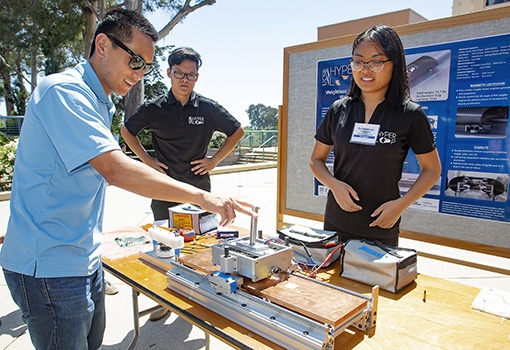Every year, senior undergraduate students in UCSB computer, electrical, mechanical, and chemical engineering complete a year-long project-based capstone course during which they develop engineered solutions to real-world problems, often with input from industry partners.
This year, students in the departments of mechanical, electrical, and computer engineering completed 24 projects, and on Friday, June 11, they presented their results, impressing the hundreds of people — faculty, sponsors, fellow students, parents, and guests from beyond UCSB — who attended the 2018 Design Expo. Judges walked the outdoor fair, talked with the students, and then awarded top honors to the following representatives from each department after presentations in Corwin Pavilion. Chemical engineering held a separate, internal capstone event on June 12.
SONOS Move — Best Technical Engineering Project in Electrical Engineering and Mechanical Engineering
Students on this multidisciplinary team (mechanical, electrical, and computer engineering) worked on the first fully portable wireless speaker in the SONOS line, which features a six-hour battery pack and onboard LTE connection that allows for WiFi connectivity.
Baby Bot Nes+ — Engineering Innovation in Mechanical Engineering
For infants affected by cerebral policy, the first nine months of life are critical, because during that period, they need to develop the ability to turn over and lift their head while on their stomach. If they fail to learn this, they may face a more severe disability; however, if they learn those motions, the brain can be rewired so that they have an easier time as they grow. The students designed a crib mattress that can turn the infant and help lift the head.
Hyperloop — The John and Sheila Lake Excellence in Electrical Engineering and Mechanical Engineering Award
This is the third Hyperloop project, and this year’s team redesigned the magnetically levitated vehicle, complete with a carbon skin The team is split into smaller subteams to focus on all subsystems of the pod: magnetic levitation, structures, stability and braking, battery and power systems, and sensors and controls. The team hopes to earn the right to “test-fly” their pod at Elon Musk’s SpaceX Hyperloop track.
Wall-E — Engineering Innovation in Computer Engineering
Students designed the Waterborne Autonomous Low Light Electrostereovideography (WALL-E). The submersible low-light camera cameras, which can be deployed in pairs, and use computer-vision techniques to analyze the courtship patterns of ostracods, which are tiny crustaceans that are found in the Caribbean Sea and produce luminous courtship displays.
Hover Hand — Engineering Innovation in Computer Engineering
Students created a glove that acts as the transmitter to a drone’s receiver, enabling the pilot to fly a quadcopter drone in a way that is more intuitive and precise.
The Hyperloop projects consist of 25-plus students, SONOS Move had ten students, and each of the other teams had three to six students.
“We had a great year in capstone,” said Tyler Susko, a lecturer who teaches nine courses in engineering design at UCSB, including the senior capstone course for mechanical-engineering. “All of the projects were strong, and nearly six hundred people attended the on-stage showcase portion of the Design Expo in Corwin Pavilion. This was by far the biggest and best event we've ever had.”
"The computer engineering capstone projects are all about building custom computer hardware and then writing software for a specific application,” said computer engineering capstone instructor Yogananda Isukapalli. “Each project requires students to use their imagination and apply a lot of rigor to come up with innovative solutions and develop working prototypes.”
The students receive key support and guidance from Susko, Isukapalli and fellow capstone instructor, Ilan Ben-Yaacov (electrical engineering), as well as from academic coordinator Steve Laguette.
Congratulations to all of the participants. To read more about the projects, go to the College of Engineering Capstone Project home page.

Hyperloop team members demonstrate their technology. Photograph by Eric Roland
